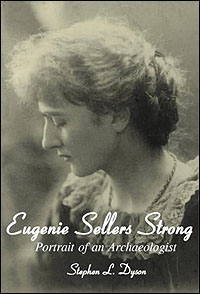Archives
NEH grant, publication of 2 books make it a stellar year for UB classicist
By PATRICIA DONOVAN
Contributing Editor
Classical archaeologist and author Stephen L. Dyson, Park Professor of Classics in the College of Arts and Sciences, has had quite a year, professionally speaking. It has seen the publication of his two important new books and the receipt of a $106,218 grant from the National Endowment for the Humanities to fund a five-week seminar for college teachers this summer at the American Academy in Rome.

The seminar, which begins this month, will focus on ways in which the archaeology of classical Rome has been influenced by cultural and intellectual changes in the modern era. Dyson directed the classical summer school of the American Academy in Rome from 1998-2000.
His new books are "The Roman Countryside" (Duckworth, 2003), in which Dyson offers a concise discussion of the many different factors that shaped the ancient Roman countryside, and "Eugenie Sellers Strong: Portrait of an Archaeologist," published in March. The latter is a pioneering biography of one of the most important, celebrated, influential—and neglected—women in the field of classical studies in the 19th and early 20th centuries. Strong may be relatively unknown, but according to Dyson, her ghost is said to still haunt the library of the British School at Rome.
His biography of Strong has been very much welcomed in the classics field. A graduate of Cambridge University, she was among the first women in England to receive a university education, and went on to become a professional archaeologist and a pioneering historian of Roman art. She also served as assistant director of the British School at Rome, where she cut a glittering figure.
A great 19th-century beauty, Strong modeled for the Pre-Raphaelites and was an active presence on the European cultural scene. She enjoyed close friendships with some of the most important writers, artists and intellectuals of her day, among them Edward Burne-Jones, Edmund Goose, Gertrude Bell, Frederick Leighton, Lady Ottoline Morrell and pioneering Greek classical archaeologist Jane Harrison.
Dyson notes that liberal MP and notorious anti-suffragist Herbert Asquith called Strong the most "distinguished woman scholar" in the world, and Prime Minister Gladstone called her his "first and only love."
Her publications include the book "Roman Sculpture From Augustus to Constantine," journal articles and a translation of archaeologist Carl Schuchhardt's discussion of "Schliemann's Excavations" at Troy, Mycenae, Tiryns and other sites. She was one of the first women to become a Fellow of the Society of Antiquaries, was a Commander of the Order of the British Empire (CBE) and received the gold medal of the City of Rome.
Strong has been a very-much-neglected figure in her field, in part because she was involved not only in the drawing rooms of pre-Raphaelite London, but in the salons of Mussolini's Italy, where she and other classical scholars were attracted to Il Duce's encouragement of archaeology and Latin studies. Dyson says this is one of a variety of reasons for which bashing Eugenie Strong has been part of British patriarchal classical discourse for a century. It helps explain why she has been overlooked by biographers in favor of her more famous friends.
"The Roman Countryside" reflects Dyson's extensive knowledge of the archaeology of provincial Rome, in whose changing topography he has long had an abiding interest. Here, he discusses current research on the Roman countryside in that context, first examining the Roman villa and the changing interpretations of the villa shaped by new information and evolving interpretive models. He then relates survey-settlement evidence to larger questions of landscape use and transformation during the ancient Roman era.
The book focuses on areas that served as the sites for innovative research on provincial Roman life: Italy, North Africa, Spain and France. Dyson discusses what happened in rural areas in the period of transition between the end of antiquity and the emergence of medieval society. He shows that the period of transition was much longer than previously thought, and cites tremendous variation, not only between one part of the Empire and another, but between micro-regions within a single province.
Dyson also is the author of "The Roman Villas of Buccino," "The Creation of the Roman Frontier," "Community and Society in Roman Italy" and "Ancient Marbles to American Shores."
He has conducted archaeological field projects in France, mainland Italy and Sardinia. A former president of the Archaeological Institute of America, Dyson twice has held the prestigious Charles Eliot Norton Lectureship of that organization. He has served as the Andrew W. Mellon Professor at the Intercollegiate Center for Classical Studies in Rome and has held fellowships from the American Council of Learned Societies and the National Endowment for the Humanities.
